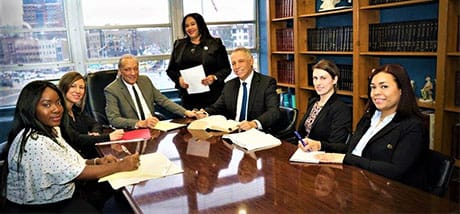CSI: New Dna Science Known As Trace Or Touch DNA On Trial In Queens County
For Immediate Release
Contact:
Todd D. Greenberg, Esq.
Addabbo & Greenberg
118-21 Queens Blvd., Suite 306
Forest Hills, New York 11375
Phone: 718-268-0400
Cell: (917) 685-5612
Fax: (718) 585-9869
[email protected]
A controversial new technique in DNA Testing and Criminal Evidence is being challenged in a Murder case in Supreme Court, Queens County, by Attorney Todd D. Greenberg of the Law Firm Addabbo & Greenberg, Forest Hills, New York.
“Trace” DNA or “Touch” DNA, also known as “low copy number” DNA, a technique with serious limitations, developed and used in the United Kingdom, is key evidence in the case of People v. Hemant Megnath, allegedly placing the victim in the Defendant’s car through an alleged blood stain on a seatbelt.
Megnath is charged with murdering Natasha Ramen in Queens on March 15, 2007 to prevent her from testifying against him in a Rape trial that was about to commence. Megnath was charged with raping Ramen in Brooklyn in 2005.
From the outset, difficulties with “Trace” DNA – a technique developed in 1997 to provide a DNA profile from forensic samples that are so small (five or less human cells) that could have been left by a mere touch – were reported, including concerns about the risks of contamination and transference, allelic drop-out and drop-in. Such phenomena increase the chance of false positives: adventitious matches with innocent individuals.
The technique was recently used in the case The Queen v. Sean Hoey, a terrorist car bombing case in Northern Ireland, known as the Omagh trial, where the Judge criticized both the science and its implementation, ultimately influencing the Judge’s “not guilty” verdict.
The discrediting of the “Trace” DNA evidence in the Omagh trial led the Police Service of Northern Ireland and the Police in England and Wales to suspend the technique, but it was reinstated after a government commissioned study – known as the “Caddy report” named after it’s author Professor Brian Caddy of Strathclyde University – found “that this technique is fit for purpose” in April 2008.
Using that information, Mr. Greenberg, Defense Counsel for Mr. Megnath, petitioned the Supreme Court, Queens County, Judge Robert Hanophy, for a “Frye” Hearing, wherein the Prosecution must establish that scientific evidence, before admission as evidence at trial, be “sufficiently established to have gained general acceptance in the particular field in which it belongs”. As examples, the results of Breathalyzer tests in DWI cases, “conventional” DNA results and fingerprint results, have met the Frye standard and such evidence is admissible in a criminal trial. Conversely, the results of a “lie Detector” test are inadmissible in that the science has not fully been accepted in the relevant scientific community.
Judge Hanophy’s Decision has important ramifications for the admissibility of “Touch” DNA evidence in future cases in New York and the United States: If the Judge finds scientific acceptance, such evidence will be admitted routinely in criminal cases.
Mr. Greenberg, during cross examination, elicited that the FBI do not use the technique and the Office of the Chief Medical Examiner of the City of New York, the proponent of the evidence in this case, is the only laboratory in the United States that uses the technique for evidentiary purposes. Quoting from the “Caddy Report”, Mr. Greenberg established that the study specifically found that there is “limited international recognition” of the technique and that “…the current state of the art… is not yet represented by a legal and scientific consensus…”. The Prosecution has established that the technique has acceptance in the European Community and is used in Court in England, Scotland, Australia and New Zealand. Further, the State of New York Division of Criminal Justice Service, DNA subcommittee, approved the use of low copy number DNA typing.
The Queens District Attorney’s Office has taken great lengths to prove it’s case by arranging for two experts in the field, Dr. Peter Gill, the Inventor of the technique, and Dr. Thomas Clayton, both prosecution Experts in the Omagh trial and residents of England, to testify in the Queens Courtroom. Similarly, the Defense has engaged Dr. Dan Krane, Professor, Department of Biological Sciences, Wright State University, an expert witness for the Defense team in the Northern Ireland case and Dr. Jason Gilder.
The “Frye” Hearing commenced in mid-November, continued in the Supreme Court on December 17th, 18th and 19th and will continue on February 11th, 2009.
Addabbo and Greenberg is one of New York’s leading full service law firms practicing in the areas of Criminal Law, Real Estate and Negligence cases. Todd D. Greenberg, Esq., a former Assistant District Attorney, has been lead counsel in over 150 Felony trials including over 50 homicide related cases.

